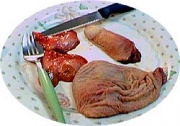Communion
Jump to navigation
Jump to search
Outside of its more mundane definition, communion is also the moment at which a cutter consumes the flesh of the person worked on (note that this interest represents only a small minority of cutters). The flesh may be consumed fresh and raw, or cooked. The word communion isn't chosen as a "joke" — cutters (and clients) who engage in this often consider it a genuinely spiritual event with genuine value to both of them.
As of the beginning of 2004, there are a number of ongoing trials to determine whether this form of cannibalism is legal or not.
